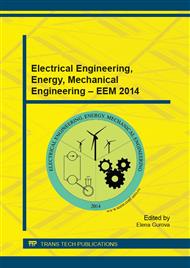[1]
A. Handbook, Vol. 4, Heat treating, ASM International, (1991).
Google Scholar
[2]
A. Handbook, Vol. 5, Surface Engineering, ASM International, (1994).
Google Scholar
[3]
I.Y. Khalfallah, M.N. Rahoma, J.H. Abboud, K.Y. Benyounis, Microstructure and corrosion behavior of austenitic stainless steel treated with laser, Opt. Laser. Technol. 43 (2011) 806-813.
DOI: 10.1016/j.optlastec.2010.11.006
Google Scholar
[4]
J.H. Abboud, K.Y. Benyounis, A.G. Olabi, M.S.J. Hashmi, Laser surface treatments of iron-based substrates for automotive application, J. Mater. Process. Technol. 182 (2007) 427-431.
DOI: 10.1016/j.jmatprotec.2006.08.026
Google Scholar
[5]
J. Yao, C. Ma, M. Gao, F. Kong, Q. Zhang, Microstructure and hardness analysis of carbon nanotube cladding layers treated by laser beam, Surf. Coat. Technol. 201 (2006) 2854-2858.
DOI: 10.1016/j.surfcoat.2006.05.047
Google Scholar
[6]
A.I. Katsamas, G.N. Haidemenopoulos, Laser-beam carburizing of low-alloy steels, Surf. Coat. Technol. 139 (2001) 183-191.
DOI: 10.1016/s0257-8972(00)01061-6
Google Scholar
[7]
A.I. Katsamas, G.N. Haidemenopoulos, Surface hardening of low-alloy 15CrNi6 steel by CO2 laser beam, Surf. Coat. Technol. 115 (1999) 249-255.
DOI: 10.1016/s0257-8972(99)00246-7
Google Scholar
[8]
A. Walker, D.R.F. West, W.M. Steen, LASER SURFACE ALLOYING OF IRON AND 1C-1. 4Cr STEEL WITH CARBON, Metal. tech. (1984) 399-404.
DOI: 10.1179/030716984803274882
Google Scholar
[9]
S. Samotugin, N. Solyanik, A. Puiko, Properties of tool steels in plasma hardening with surface melting. (MITS WP 1797), Weld. Int. 9 (1995) 20-24.
DOI: 10.1080/09507119509548840
Google Scholar
[10]
J. Nikolaou, L. Bourithis, G. Papadimitriou, Selective case hardening of plain steel by carbon alloying with a plasma transferred arc (PTA) technique, J. Mater. Sci. 38 (2003) 2883-2891.
DOI: 10.1016/s0921-5093(03)00511-2
Google Scholar
[11]
I. Bataev, M. Golkovskii, A. Bataev, A. Losinskaya, R. Dostovalov, A. Popelyukh, E. Drobyaz, Surface hardening of steels with carbon by non-vacuum electron-beam processing, Surf. Coat. Technol. 242 (2014) 164-169.
DOI: 10.1016/j.surfcoat.2014.01.038
Google Scholar
[12]
I.A. Bataev, A.A. Bataev, M.G. Golkovsky, A.Y. Teplykh, V.G. Burov, S.V. Veselov, Non-vacuum electron-beam boriding of low-carbon steel, Surf. Coat. Technol. 207 (2012) 245-253.
DOI: 10.1016/j.surfcoat.2012.06.081
Google Scholar
[13]
I.A. Bataev, A.A. Bataev, M.G. Golkovski, D.S. Krivizhenko, A.A. Losinskaya, O.G. Lenivtseva, Structure of surface layers produced by non-vacuum electron beam boriding, Appl. Surf. Sci. 284 (2013) 472-481.
DOI: 10.1016/j.apsusc.2013.07.121
Google Scholar
[14]
E.A. Bataeva, I.A. Bataev, V.G. Burov, L.I. Tushinskii, M.G. Golkovskii, Effect of initial state on inhomogeneity of the structure of carbon steels hardened by electron-beam treatment at atmospheric pressure, Met. Sci. Heat Treat. 51 (2009).
DOI: 10.1007/s11041-009-9124-x
Google Scholar


